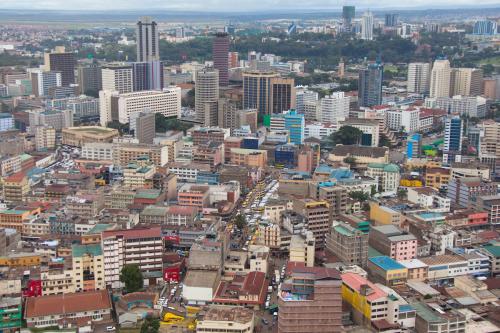The long-term horizon of the Sustainable Development Goals (SDGs) poses a challenge to any elected government since their achievement depends on sustained efforts across multiple election cycles. While municipal governments and mayors across the world voluntarily demonstrate significant leadership on sustainable development, they face special challenges in advancing progress, as their policy choices are often more constrained and their internal capacity more limited than national counterparts. As a result, for example, many U.S. cities have made limited progress on their climate change pledges. The expectations for a quick and sure economic recovery from COVID-19 add additional pressure to rebalance local priorities in favor of short-term growth at the expense of considering long-term consequences.
As cities seek to consolidate and institutionalize longer-term commitments to the SDGs, several common approaches are beginning to emerge.
1. Some cities are turning to resolutions and other political mandates to secure the SDG agenda across political cycles.
In some instances, mutually reinforcing policy objectives between the national and local governments normalize aspirations, enabling them to persist. In Mexico City, consistent sustainability objectives have been mainstreamed over 20 years in the city’s development plans, reinforced by the country’s constitutional mandate to “foster sustainable development.”
More commonly, however, local elected officials are turning to their legislative power to set a long-term footprint. Based on a local law, New York institutionalized the creation of a city strategy with mandates for regular public reporting. In 2015, it aligned that strategy, OneNYC, to the SDGs, and now its reporting—through the Voluntary Local Reviews (VLRs) that it pioneered—has become integrated with that mandate.
While they do not constitute a similarly strong accountability tool, a nonbinding resolution voted by the city council can provide several degrees of long-term credibility. Such resolutions signal to constituents and partners an alignment among city council members on key aspirations and priorities. They also provide “political cover” and an opportunity for civil servants to pursue more targeted strategies and integrate the considerations of the SDGs more fully into their work. Civil servants working on the SDGs often develop a city council strategy to get a vote on a resolution. In Madrid, a useful approach to secure this political buy-in while avoiding over-politicization has been to combine internal efforts within the city council with an acknowledgement of the benefits of integrating the city’s SDG strategy with the national recovery and spending plans.
These nonbinding resolutions also offer an entry point to securing wider buy-in from different partners and stakeholders in the community. The more partners co-brand these goals, the more “culturally appropriate” they become. For instance, Orlando’s updated sustainability and resilience plan (Green Works CSAP) co-branded with the SDGs, and was the first attempt to align the global goals with local priorities and take advantage of existing local awareness. It led to a 2018 resolution with specific clauses linking to the SDGs. The leadership of the city government helped create momentum, with other local institutions incorporating or referencing the SDGs in their strategies and activities: local universities (UCF GEEO center), neighboring city and county governments (Regional Resilience Collaborative), and a local philanthropic foundation (Thrive Central Florida). In other cases, nongovernment actors demonstrate more advanced leadership than the local governments, and their efforts catalyze and inspire municipal action, creating new norms and expectations.
2. New models of governance spurred by the SDGs can create “facts on the ground” that make it more likely to sustain efforts over time.
Cities use structures of governance as a means of institutionalizing the SDGs. Through the Bristol OneCity governance structure, city leaders have formed habits and created partnerships across sectors to strategize and lead together on city priorities. Regular stakeholder gatherings using the SDG framework led to city structures that facilitate collaboration, communication, and information-sharing on a collective set of priorities. While the city’s SDG plan remains associated with the mayor’s priorities, the system of strategy development and implementation, which has included the creation and leadership of six multistakeholder City Boards to drive the achievement of the local goals, will be harder to deconstruct. As the SDGs permeate local partnerships among local organizations and enable the leadership and contributions of this influential set of local stakeholders, a succeeding mayor will face political risk in dismantling these governance structures.
Demonstrating the nonpartisan dimension of equity and sustainability goals can help maintain them. In Bogota, the integration of the SDGs and climate goals by key government offices allowed the incumbent administration to maintain previous plans and efforts. Meanwhile, Pittsburgh has aligned its OnePGH city plan to the SDGs, reinforcing its long-term commitment to equity through the establishment of equity indicators measuring progress and securing investment commitments from local nonprofits to advance its initiatives. These arrangements will soon face a stress test as their mayor transitions.
3. Integrating the SDGs into regular city decisionmaking processes, such as the budgetary process, can also enable consistency.
The process by which cities make decisions on allocating their resources and public spending is a powerful tool to advance progress on the SDGs and make them an integral function of the city’s action. During and exiting the COVID-19 crisis, decisions over priorities will have important effects on the recovery. Within their budget constraints, they need to balance excellence in delivering basic services with their long-term aspirations and priorities. In particular, investing in an equitable and sustainable recovery from the COVID-19 crisis requires rethinking the process of budget formulation and decisionmaking.
By mapping budgets to the SDGs, cities reinforce the durability of their efforts to achieve them. For instance, Malmo developed a process to integrate the city’s SDGs objectives and planning into the city’s budgeting decisions: The budget cycle includes a strategic dialogue between specialists from the economic and sustainability units at the City Office to ensure budget aligns with the city’s commitment to the SDGs. Analyzing the development in Malmö with the SDGs has become an integral part of defining the city’s budget goals for each cycle. The city of Strasbourg has aligned in detail its annual budget and expenditures to the SDGs, identifying the main and secondary SDG targets related to each budget line, while Sardinia has developed a financial tracking tool to transparently show how financial expenditures align against the SDGs.
4. Cities can promote citizen participation to secure long-term buy-in.
Using the SDGs in a participatory way helps create accountability that extends beyond an elected government. In Mannheim, the city government involved its citizens through a participatory planning process to define the city’s strategy, using surveys, focus groups, and public engagement. Democratizing the process connects residents in a tangible way to the local sustainability objectives, and the hope is that this may increase its resistance to political turnover. Even creating a widespread public campaign that encourages citizen contributions toward the SDGs, such as in Utrecht, can facilitate a shift in community mindset or norms that persists beyond one particular administration or elected leader.
Participatory budgeting has also successfully used the common language of the SDGs, helping facilitate citizen voice during the city’s allocation of resources in their communities. In Mexico City and Paris, legislation allocates a percentage of public resources to participatory budgeting. Helsinki and Mannheim have also implemented participatory budgeting. This has provided an additional platform for building public support for policies that prioritize the objectives reflected in their commitment to the SDGs. The devil can be in the details, as there can be challenges ensuring representative participation (e.g., digital representation), and the influence of the citizen input is not always clear. But this is a good example of a governance tool that shares synergies with a sustainable development agenda and can be mutually reinforcing.
Conclusion
The aspirations and principles of the SDGs will become durable at the local level when expectations and behavior change across community norms, governance structures, and policymaking. Building an SDG-oriented culture, both within and beyond city government, can create a sense of shared momentum and similar priorities among all stakeholders. What is perhaps most powerful is that the SDGs are providing a common language and framework that forward-thinking localities are using to enable such shifts. Whether or not future elected administrations continue to use SDG branding, there are indications that commitments to equity and sustainability can be mainstreamed into city processes, and that the expectations of external stakeholders and citizens can shift to ensure continued political attention. This may be the lasting legacy of the “SDG effect.”






Commentary
Ensuring the durability of local commitments to the SDGs
June 18, 2021